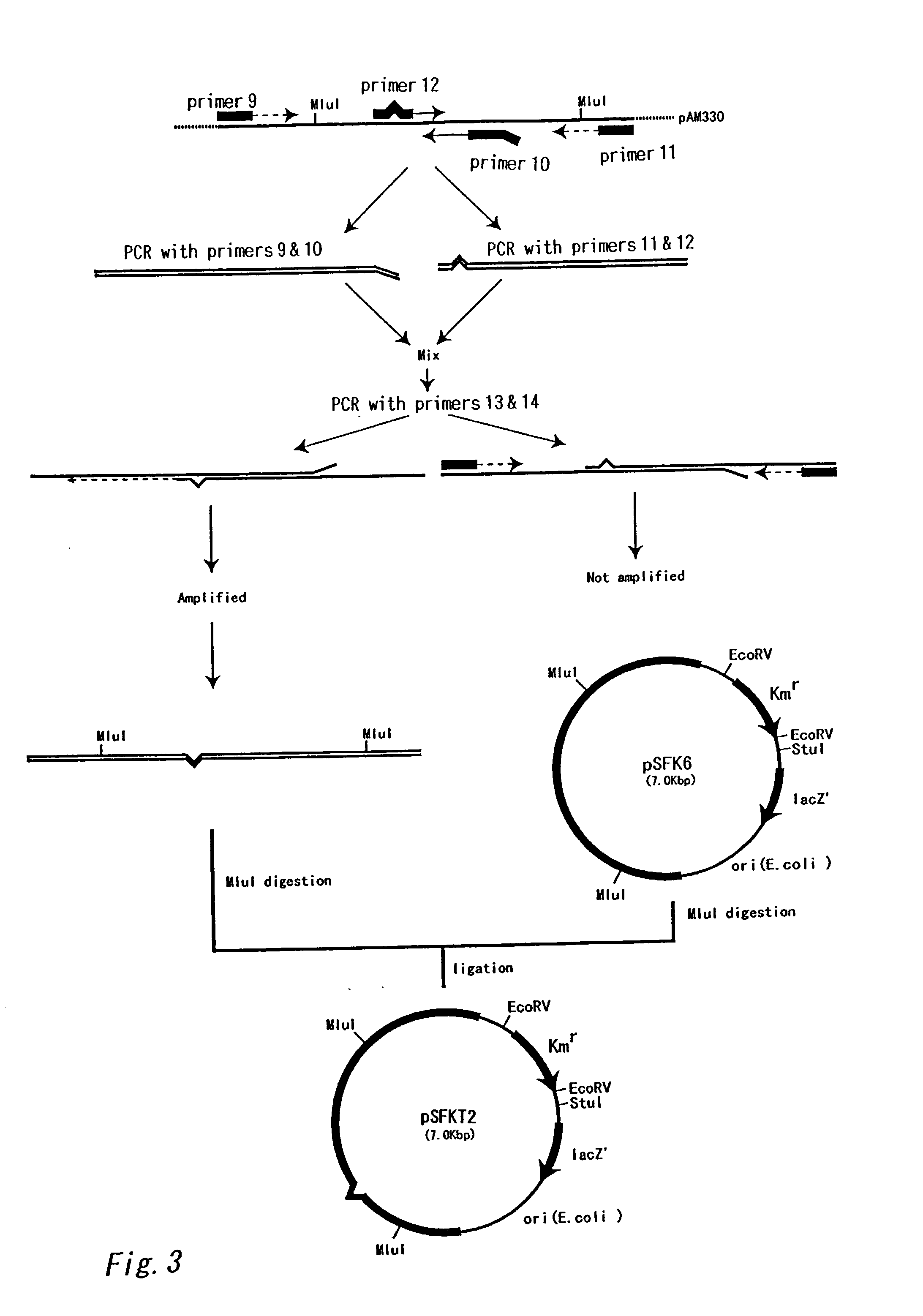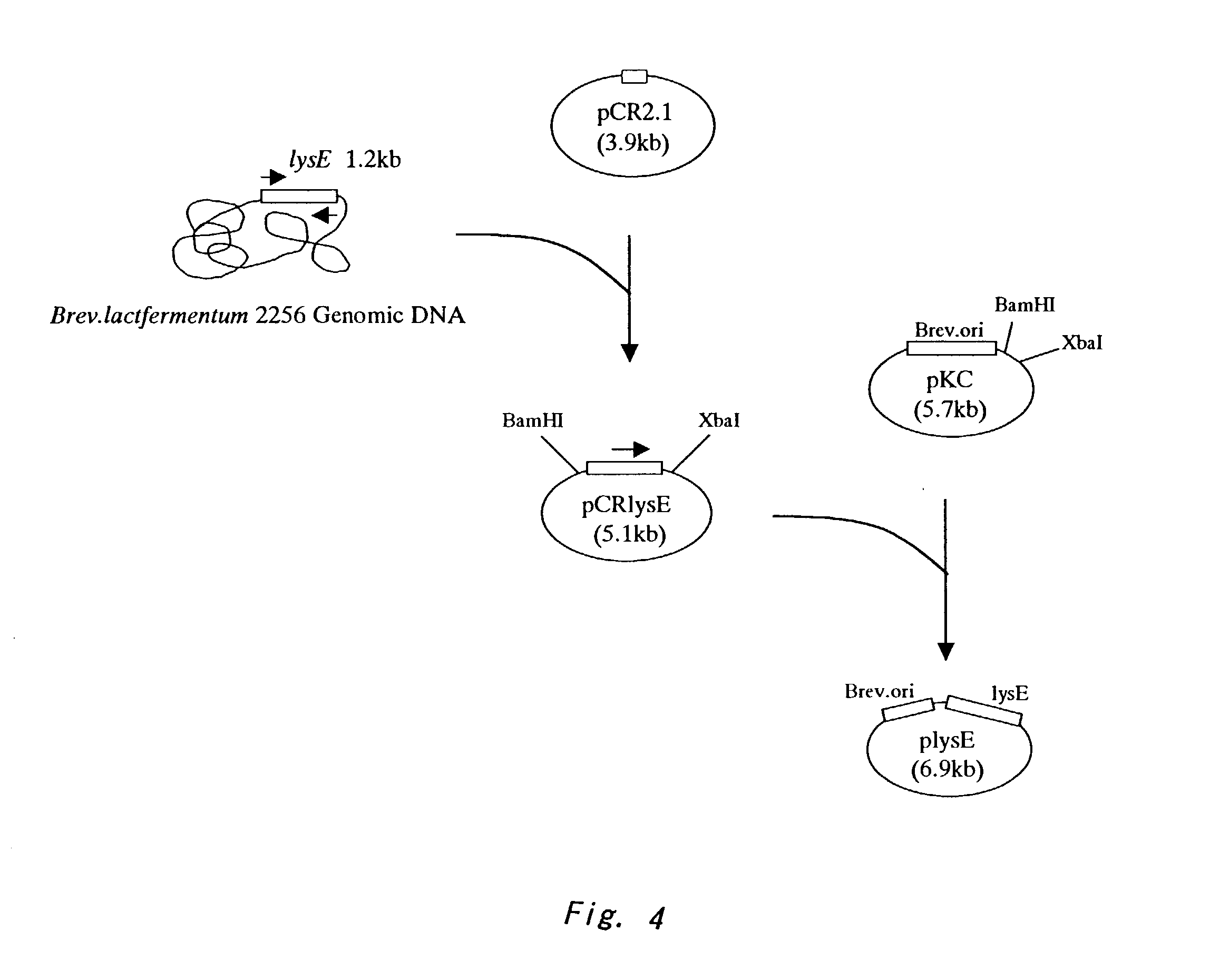Method for producing L-arginine
- Summary
- Abstract
- Description
- Claims
- Application Information
AI Technical Summary
Benefits of technology
Problems solved by technology
Method used
Image
Examples
example 1
Constructions of Shuttle Vector for Escherichia coli and Coryneform Bacterium and Temperature Sensitive Vector
[0134] First, a vector for introducing an argR gene into a coryneform bacterium and a temperature sensitive vector for producing an argR deficient strain of coryneform bacterium were constructed.
[0135] Construction of Vector Having Drug Resistance Gene of Streptococcus faecalis
[0136] The kanamycin resistance gene of Streptococcus faecalis was amplified by PCR from a known plasmid containing the gene. The nucleotide sequence of the kanamycin resistance gene of Streptococcus faecalis has already been elucidated (Trieu-Cuot, P. and Courvalin, P.: Gene 23 (3), 331-341 (1983)). Based on this sequence, the primers shown as SEQ ID NOS: 1 and 2 were synthesized, and PCR was performed by using them and pDG783 (Anne-Marie Guerout-Fleury et al., Gene, 167, 335-337 (1995)) as a template to amplify a DNA fragment containing the kanamycin resistance gene and its promoter.
[0137] The aforem...
example 2
Cloning of argR Gene and Amplification Effect Thereof in Coryneform Bacterium
[0147] PCR was performed by using chromosome DNA of the Brevibacterium flavum wild strain 2247 (AJ14067) as a template and the oligonucleotides having the nucleotide sequences shown as SEQ ID NO: 15 (sequence of the nucleotide numbers 1717-1741 in SEQ ID NO: 17) and SEQ ID NO: 16 (sequence complementary to the sequence of the nucleotide numbers 2386-2362 in SEQ ID NO: 17) as primers. PCR was performed for 30 cycles each consisting of reactions at 98.degree. C. for 10 seconds, 58.degree. C. for 1 minute and 72.degree. C. for 3 minutes by using Pyrobest DNA polymerase (Takara Shuzo). The obtained amplified fragment was inserted into the SmaI site of the shuttle vector pSFK6 obtained in Example 1 to obtain a plasmid pWR autonomously replicable in coryneform bacteria.
[0148] In order to investigate the amplification effect of argR gene in L-arginine producing coryneform bacteria, pWR was introduced into an L-arg...
example 3
Construction of argR-Disrupted Strain of Coryneform Bacterium and Effect of Deletion of Arginine Repressor
[0151] Construction of Plasmid for argR Disruption
[0152] PCR was performed by using chromosome DNA of a Brevibacterium flavum wild strain, 2247 strain (AJ14067), as a template and the oligonucleotides having the nucleotide sequences shown as SEQ ID NO: 19 (sequence of the nucleotide numbers 4-28 in SEQ ID NO: 17) and SEQ ID NO: 20 (sequence complementary to the sequence of the nucleotide numbers 4230-4211 in SEQ ID NO: 17) as primers (Primers 3 and 4). PCR was performed for 30 cycles each consisting of reactions at 98.degree. C. for 10 seconds, 58.degree. C. for 1 minute and 72.degree. C. for 3 minutes by using Pyrobest DNA polymerase (Takara Shuzo). The obtained amplified fragment was inserted into the SmaI site in the multicloning site of cloning vector pHSG399.
[0153] In order to delete the whole ORF considered to encode the arginine repressor from the inserted DNA fragment, P...
PUM
| Property | Measurement | Unit |
|---|---|---|
| Density | aaaaa | aaaaa |
| Density | aaaaa | aaaaa |
| Density | aaaaa | aaaaa |
Abstract
Description
Claims
Application Information
 Login to View More
Login to View More - R&D
- Intellectual Property
- Life Sciences
- Materials
- Tech Scout
- Unparalleled Data Quality
- Higher Quality Content
- 60% Fewer Hallucinations
Browse by: Latest US Patents, China's latest patents, Technical Efficacy Thesaurus, Application Domain, Technology Topic, Popular Technical Reports.
© 2025 PatSnap. All rights reserved.Legal|Privacy policy|Modern Slavery Act Transparency Statement|Sitemap|About US| Contact US: help@patsnap.com



